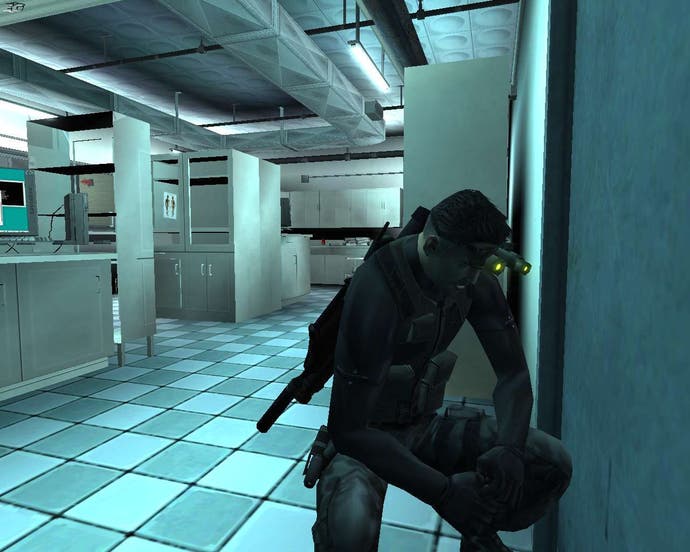Splinter Cell
Hands-On - our take on ECTS' stunning Game Of The Show
I'm about to state the obvious, but I need to get this off my chest - Splinter Cell looks stunning. Every single thing about the game is stunning, from the characters and their beautiful flowing animations, the design of the weapons and gadgets and the scenery right down to the way a piece of plastic curtain flows and refracts light when disturbed. Our time with the game at ECTS 2002 revealed exactly why we should be excited about yet another Tom Clancy license from Ubi Soft.

Multi-Talented
You probably already know that Splinter Cell won a Best of Show award for Ubi Soft at this year's ECTS, and we can't stress enough how well deserved that award was. There has been no other game to catch our attention quite so pointedly, and no other game has caused us to stand peering up at the screen with our mouths agape. It really is a sight to behold as we take our protagonist, Sam Fischer, sweeping through what appears to be a secure prison facility, effortlessly bounding from one wall, then the other and finally supporting himself with both legs at the ceiling of a corridor in the relative safety of the shadows.
Throughout the game there are a number of ways to approach each problem using a variety of tools. My own favourite method of approach was to suspend Sam in the shadows, switch on the night-vision goggles and shoot out all the lights, plunging the corridor into darkness so that you can drop to the ground and initiate a silent takedown on the unsuspecting guards in safety. If you fancy taking a more subtle approach, we were told that it is entirely possible to progress through the whole game without killing a single person, and this is a challenge that many will relish.
There are times when only one method will do, such as when your mission calls for the interrogation of a key character. Stepping silently up behind our target, we were able to tap the A button, get him in a chokehold and put a gun to his head. Subsequent pressing of A questioned the subject further until you gained all of the necessary information. A pull of the control pad trigger at this point delivered a pistol whip to the back of his head, and our hostage slumped to the ground.

It's All In The Detail
There is a vast amount of functionality of this kind squeezed onto the Xbox pad, and at first the controls can seem fiddly to master. Extended play reveals that this complexity is a necessary evil though - it is, after all, a complex game. Sam Fischer has an array of gadgets and weapons to utilise, and they're all brilliantly implemented. Sidling up to a locked door in the shadows, we had a peek through our inventory and picked the fibre optic camera. A quick tug on the trigger button and Sam slipped the camera under the door, our perspective switching to a light enhanced view of the room, which we could rotate with the right analogue stick. We could barely stifle our chuckles of delight.
The camera helped us to identify a threat behind the door. We then used a small tool that appeared to blow the lock off the door, enabling us to slip in and issue a swift dispatch with ease. Whatever he's doing though, Sam conducts all of his operations in a slickly animated manner, stalking about rooms and corridors in the shadows with complete silence. The brilliant motion effects don't stop at Sam, either - they extend from the game's other characters right down to pieces of paper caught in the breeze and birds flapping about in a tree outside the window, moonlight casting their shadows onto the floor.
Detail is very much a factor in Splinter Cell, and this is obvious right from the very start. For example, Sam could pick up a discarded bottle if you so wished, tossing it to create a distraction for the guards. Another example is the use of the plastic sheet we mentioned earlier; you need to enter a morgue and examine a body, but the cameras connected to the alarm system are detecting your movement. Slipping behind the barely translucent curtain and stepping slowly forwards, it covers you like a sheet and spreads over your body to create a shield through which the cameras can't detect you. The environments themselves are full of minutiae, and are as much a tool to aid your progress as your weapons and gadgets. Planning your approach properly and utilising the darkness as a disguise has never been this important.
Conclusion
It's not often that you get to see a game running for twenty minutes and know that it's a killer app, but if only one game at ECTS deserved that title, then Splinter Cell is it. If this had been totally Xbox exclusive, we'd be confident enough to tell you to buy the system purely for Splinter Cell. This game is important, so miss its November arrival at your own cost - it's time for Solid Snake to retire.








